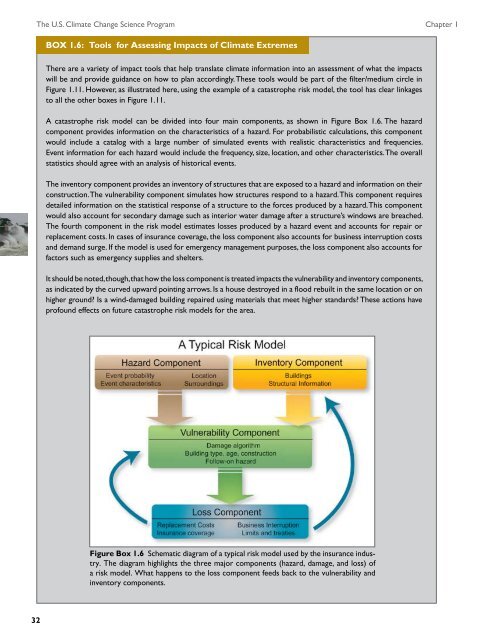Weather and Climate Extremes in a Changing Climate. Regions of ...
Weather and Climate Extremes in a Changing Climate. Regions of ...
Weather and Climate Extremes in a Changing Climate. Regions of ...
Create successful ePaper yourself
Turn your PDF publications into a flip-book with our unique Google optimized e-Paper software.
The U.S. <strong>Climate</strong> Change Science Program Chapter 1<br />
32<br />
BOX 1.6: Tools for Assess<strong>in</strong>g Impacts <strong>of</strong> <strong>Climate</strong> <strong>Extremes</strong><br />
There are a variety <strong>of</strong> impact tools that help translate climate <strong>in</strong>formation <strong>in</strong>to an assessment <strong>of</strong> what the impacts<br />
will be <strong>and</strong> provide guidance on how to plan accord<strong>in</strong>gly. These tools would be part <strong>of</strong> the filter/medium circle <strong>in</strong><br />
Figure 1.11. However, as illustrated here, us<strong>in</strong>g the example <strong>of</strong> a catastrophe risk model, the tool has clear l<strong>in</strong>kages<br />
to all the other boxes <strong>in</strong> Figure 1.11.<br />
A catastrophe risk model can be divided <strong>in</strong>to four ma<strong>in</strong> components, as shown <strong>in</strong> Figure Box 1.6. The hazard<br />
component provides <strong>in</strong>formation on the characteristics <strong>of</strong> a hazard. For probabilistic calculations, this component<br />
would <strong>in</strong>clude a catalog with a large number <strong>of</strong> simulated events with realistic characteristics <strong>and</strong> frequencies.<br />
Event <strong>in</strong>formation for each hazard would <strong>in</strong>clude the frequency, size, location, <strong>and</strong> other characteristics. The overall<br />
statistics should agree with an analysis <strong>of</strong> historical events.<br />
The <strong>in</strong>ventory component provides an <strong>in</strong>ventory <strong>of</strong> structures that are exposed to a hazard <strong>and</strong> <strong>in</strong>formation on their<br />
construction. The vulnerability component simulates how structures respond to a hazard. This component requires<br />
detailed <strong>in</strong>formation on the statistical response <strong>of</strong> a structure to the forces produced by a hazard. This component<br />
would also account for secondary damage such as <strong>in</strong>terior water damage after a structure’s w<strong>in</strong>dows are breached.<br />
The fourth component <strong>in</strong> the risk model estimates losses produced by a hazard event <strong>and</strong> accounts for repair or<br />
replacement costs. In cases <strong>of</strong> <strong>in</strong>surance coverage, the loss component also accounts for bus<strong>in</strong>ess <strong>in</strong>terruption costs<br />
<strong>and</strong> dem<strong>and</strong> surge. If the model is used for emergency management purposes, the loss component also accounts for<br />
factors such as emergency supplies <strong>and</strong> shelters.<br />
It should be noted, though, that how the loss component is treated impacts the vulnerability <strong>and</strong> <strong>in</strong>ventory components,<br />
as <strong>in</strong>dicated by the curved upward po<strong>in</strong>t<strong>in</strong>g arrows. Is a house destroyed <strong>in</strong> a flood rebuilt <strong>in</strong> the same location or on<br />
higher ground? Is a w<strong>in</strong>d-damaged build<strong>in</strong>g repaired us<strong>in</strong>g materials that meet higher st<strong>and</strong>ards? These actions have<br />
pr<strong>of</strong>ound effects on future catastrophe risk models for the area.<br />
Figure Box 1.6 Schematic diagram <strong>of</strong> a typical risk model used by the <strong>in</strong>surance <strong>in</strong>dustry.<br />
The diagram highlights the three major components (hazard, damage, <strong>and</strong> loss) <strong>of</strong><br />
a risk model. What happens to the loss component feeds back to the vulnerability <strong>and</strong><br />
<strong>in</strong>ventory components.




